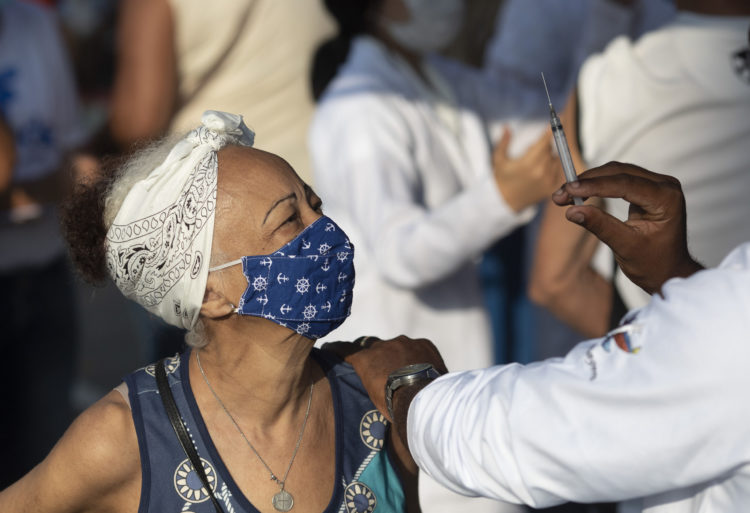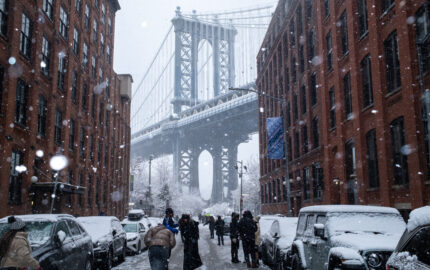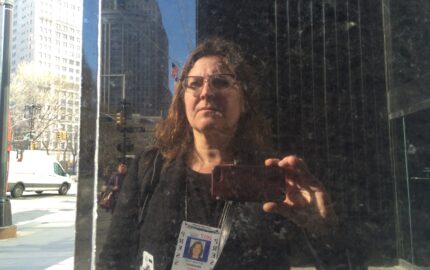We invite you to spend a few moments traveling the world with photographers who, despite the risks of COVID, have remained on the front lines of storytelling. For more than a year now, photographers have taken us into the intimate horrors of the pandemic, even as most writers have worked from a distance. Since the release of multiple vaccines, much of the news coverage has shifted to the global inoculation effort — and to the many challenges that hinder it. Some of the barriers are institutional, and have to do with economics and production capacity and supply chains. Too many are political, as chests are thumped over who is first in line. But the ones I find most confounding are human: People who, for whatever reason, feel they are being hoodwinked.
Please take a tour through this vaccination photo essay by the Atlantic. I have spent my career forging stories from words. But I recognize when photos top any narrative I could fashion. This struck me as one of those times. Faces and clothing and settings from places near and foreign, and yet with one central theme: Hope.
It's not a Pollyanna display. In some places, the captions make clear that this is the first time vaccines have been available while the virus still rages; the race against time seems more than a long shot, and it's inevitable that too many will be left behind. In the U.S., of all blessed places, this comes as health officials warn with dread of a deadly fourth surge.
But I look at the face of the woman above, in the photo by Silvia Izquierdo in Brazil, and photos of people from different places and different lives, and see a common humanity: relief, gratitude, and yes, hope.
Years and years ago, I sat in a rough cabin in the far northern Minnesota woods, interviewing a man who was zealous in his fight against fluoridation of the local water supply. I was a cub, maybe three years into my reporting career, and in love with any assignment that didn't have me fidgeting in a government meeting or deciphering a government budget. I can't remember how I got to the cabin: Did I drive down a narrow forest trail, or hike in? I can't remember if the man lived fully off-the-grid: If he did, why was he concerned about community water? I do remember asking why his opposition to fluoride ran so deep, and not knowing what to do with his answer: He believed it was a government plot to emasculate men and render them passive followers.
I approached reporting back then with open curiosity — some would call it naive wonder — coded by Midwestern common sense. For all the mistakes I no doubt made with that story, I like to think I employed two of the most important questions a reporter can ask: "Really?" and "How do you know that?"
I've been thinking about that man's anti-fluoride passions as I watch the erratic, round-the-world roll-out of COVID vaccines, and do my daily swim through COVID news. I try to resurrect my open curiosity as I read about the continued resistance many have to being vaccinated. But mostly I bump into my Midwestern common sense and some childhood memories.
I am of the generation that straddled pre- and post-fluoridation. It was first introduced to water systems in 1945, but didn't come to my Wisconsin village until I was getting my permanent teeth; I have the silver fillings to show for that early lack. I was born the year the polio epidemic hit its peak in the U.S., and Jonas Salk began testing the first polio vaccine; it would still be some time until the vaccine was deemed safe for wide distribution. I remember my childhood dread of being marched in with my older brothers for our polio shots — but also remember summer after summer when beaches were closed before the virus was brought to heel. In my early 20s, I had a boyfriend who had spent months of his childhood in an iron lung because of polio, and still had one leg that was less muscled than the other.
All this came back as I drove over a mountain pass to get my second Pfizer shot recently. I long ago lost my fear of needles. Enough flu vaccines, dental procedures and surgical episodes make even the biggest needle seem a minor thing — a temporary grimace at most. I didn't feel my first COVID shot at all; I asked the nurse if she was sure the syringe had emptied. But a few moments later, I felt a massive wave of relief.
I try to understand the many people who declare their opposition to the COVID vaccine. It's not been properly tested. It's a government conspiracy. It's a violation of their freedom.
Really? How do they know that?
I try to keep personal politics out of this space. But this one is tough. I was kept from beaches as a child, but also kept from a debilitating disease. I've had years of flu-free winters. I've reported from some of the most disease-ridden spots in the world and come home healthy. I count on science to keep me from the worst of shingles and pneumonia as I age. My teeth are silvered but strong.
Funny the things you remember, and what provokes those memories. I don't remember if I asked the man in the cabin, all those years ago, about his teeth. I probably didn't know how, at the time, to go to that daring but relevant place, and to do so without judgment but with true curiosity guided by common sense. I don't know any other way to report these things — but I know it must be done, and I am grateful to the working press that continues to ask.
***
A version of this post first ran as a Nieman Storyboard newsletter on April 2, 2021.
Please take a tour through this vaccination photo essay by the Atlantic. I have spent my career forging stories from words. But I recognize when photos top any narrative I could fashion. This struck me as one of those times. Faces and clothing and settings from places near and foreign, and yet with one central theme: Hope.
It's not a Pollyanna display. In some places, the captions make clear that this is the first time vaccines have been available while the virus still rages; the race against time seems more than a long shot, and it's inevitable that too many will be left behind. In the U.S., of all blessed places, this comes as health officials warn with dread of a deadly fourth surge.
But I look at the face of the woman above, in the photo by Silvia Izquierdo in Brazil, and photos of people from different places and different lives, and see a common humanity: relief, gratitude, and yes, hope.
Answers don't always bring understanding
Years and years ago, I sat in a rough cabin in the far northern Minnesota woods, interviewing a man who was zealous in his fight against fluoridation of the local water supply. I was a cub, maybe three years into my reporting career, and in love with any assignment that didn't have me fidgeting in a government meeting or deciphering a government budget. I can't remember how I got to the cabin: Did I drive down a narrow forest trail, or hike in? I can't remember if the man lived fully off-the-grid: If he did, why was he concerned about community water? I do remember asking why his opposition to fluoride ran so deep, and not knowing what to do with his answer: He believed it was a government plot to emasculate men and render them passive followers.
I approached reporting back then with open curiosity — some would call it naive wonder — coded by Midwestern common sense. For all the mistakes I no doubt made with that story, I like to think I employed two of the most important questions a reporter can ask: "Really?" and "How do you know that?"
I've been thinking about that man's anti-fluoride passions as I watch the erratic, round-the-world roll-out of COVID vaccines, and do my daily swim through COVID news. I try to resurrect my open curiosity as I read about the continued resistance many have to being vaccinated. But mostly I bump into my Midwestern common sense and some childhood memories.
I am of the generation that straddled pre- and post-fluoridation. It was first introduced to water systems in 1945, but didn't come to my Wisconsin village until I was getting my permanent teeth; I have the silver fillings to show for that early lack. I was born the year the polio epidemic hit its peak in the U.S., and Jonas Salk began testing the first polio vaccine; it would still be some time until the vaccine was deemed safe for wide distribution. I remember my childhood dread of being marched in with my older brothers for our polio shots — but also remember summer after summer when beaches were closed before the virus was brought to heel. In my early 20s, I had a boyfriend who had spent months of his childhood in an iron lung because of polio, and still had one leg that was less muscled than the other.
The two best questions
All this came back as I drove over a mountain pass to get my second Pfizer shot recently. I long ago lost my fear of needles. Enough flu vaccines, dental procedures and surgical episodes make even the biggest needle seem a minor thing — a temporary grimace at most. I didn't feel my first COVID shot at all; I asked the nurse if she was sure the syringe had emptied. But a few moments later, I felt a massive wave of relief.
I try to understand the many people who declare their opposition to the COVID vaccine. It's not been properly tested. It's a government conspiracy. It's a violation of their freedom.
Really? How do they know that?
I try to keep personal politics out of this space. But this one is tough. I was kept from beaches as a child, but also kept from a debilitating disease. I've had years of flu-free winters. I've reported from some of the most disease-ridden spots in the world and come home healthy. I count on science to keep me from the worst of shingles and pneumonia as I age. My teeth are silvered but strong.
Funny the things you remember, and what provokes those memories. I don't remember if I asked the man in the cabin, all those years ago, about his teeth. I probably didn't know how, at the time, to go to that daring but relevant place, and to do so without judgment but with true curiosity guided by common sense. I don't know any other way to report these things — but I know it must be done, and I am grateful to the working press that continues to ask.
***
A version of this post first ran as a Nieman Storyboard newsletter on April 2, 2021.



